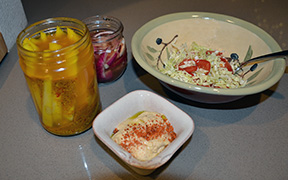Numerous countries in Central Asia have a name that ends in "stan,":
Kazakhstan, Kyrgyzstan
Turkmenistan, Uzbekistan
And Tajikistan
As a generally accepted explanation, the suffix "stan" is an ancient Persian and/or Farsi word meaning country, nation, land, or place of, so, the country name of Afghanistan would then mean "homeland" of the Afghans, or place of the Afghans. (cited from: https://www.worldatlas.com/aatlas/infopage/stan.htm)
Tajikistan is my food destination. From the same site: Tajikistan In Persian, taj means "crown" and ik means "head," so tajik means "a person wearing a crown on his head." Tajiks were originally Persians.
I never thought much about the Stans. I have eaten Afghani dishes. I am familiar with how Pakistan came to be. There is a lot of news about these two countries over the last 18 years, but I will not digress into politics. So, when I pulled Tajikistan out of the hat, I thought hmmmm, this should be interesting.
The country sits pretty much in the middle of the Stans. Except for the two aforementioned Stans, all were once part of the Soviet Union. The country gained independence in September 1991 when the Soviet Union fell. There is deep history in this part of the world. Tajikistan’s history includes routes on the Silk Road. The famous trade routes between China and Europe.
The bread, Non, is very interesting. Not because the recipe is unique, the ingredients are a common combination in bread making. It’s the bread stamps used to decorate the bread. Yes, bread stamps. Unbeknownst to me, stamping bread has been around since the Egyptians first started making bread. The stamps were used to let customers know who produced the bread or that it was from an official source.
 |
| Market Bread |
In Tajik tradition, as far as I can tell, the flat bread is stamped for decorative reasons. The stamps are made of walnut wood and have metal pins set in many patterns. I was intrigued. So, I went on the hunt for bread stamps. Uzbekistan has quite a market for bread stamps. The cost is VERY cheap in Uzbekistan markets and fairly spendy on Etsy or Amazon. I kept telling myself that was too much to pay, I didn’t need bread stamps from Uzbekistan. Both Etsy & Amazon orders are shipped from Uzbekistan, I now have the packaging to prove it. I admit, I cannot pass up a kitchen gadget. Plus, this was less expensive that a trip to Uzbekistan. But now it’s on my list.
So now I have a set of three Uzbek bread stamps to make Tajik flat bread pretty. Whatever.
One of Tajikistan’s national dishes is palov. This is a meat and rice dish, think pilaf, prepared with either beef or lamb.
Tajik cuisine is not heavy on vegetables or dessert. I actually could not find a dessert recipe. Doesn’t mean there aren’t any I suppose. Nor were there much in the way of vegetable sides. I found Qurtob to be the most appetizing. It is basically a tomato, onion and cucumber salad. It might have a yogurt/cream sort of cheese underneath or toasted bread mixed in. The dressing iMy tummy doesn’t do well with raw onions so I will need to skip eating the onion.
So, my menu is Non, Beef Plov and Qurtob.
The bread is very similar to making naan or pita. After the dough is flattened dip the bread stamp in oil and press into the dough. A very sharp knife can be used to slash the dough as well as a fork for varied patterns. Recipe inspiration: Yogurt Naan/Non | Global Table Adventure
The preparation of the plov reminded me of chicken and rice. Although the meat and vegetables are cooked first in a broth and then the rice is added. Very tasty and filling. The salad was fine. The addition of ground coriander to the olive oil and lemon/vinegar dressing added a nice flavor. So here you have it, a small trip to Tajikistan. Palov recipe: Beef Plov (Beef Rice Pilaf) Recipe (natashaskitchen.com).
I combined a few recipes for the salad. Here's my take:
Tajikistan
Salad ‘Qurtob’
2 tablespoon lemon juice
1 tablespoon rice vinegar or cider vinegar
1 teaspoon sugar
¾ teaspoon ground coriander
3 ounces extra virgin olive oil
4 large ripe tomatoes, chopped
½ cucumber, halved lengthwise, seeded and sliced
3 spring onions, thinly sliced
small bunch of coriander leaves, chopped
small bunch of dill, chopped
3 ounces feta, crumbled
To make the dressing, mix the lemon juice, vinegar, sugar and coriander in a bowl. Gradually whisk in the olive oil until well blended, then season with salt.
Put the tomatoes, cucumber and spring onions into a large serving dish and toss with the dressing and herbs. Crumble over the feta. Toss once and serve.













